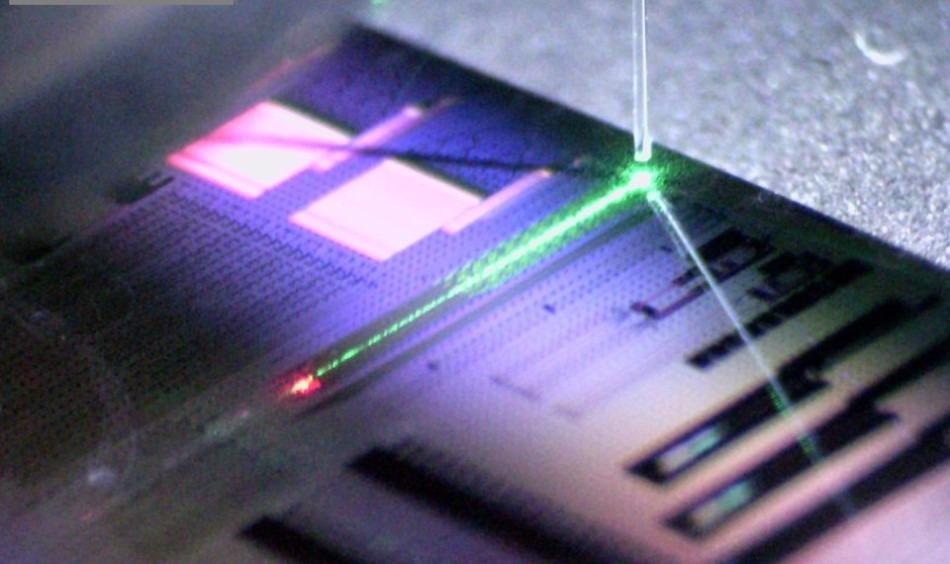Expanding on its previous advances in integrated optics and silicon photonics, CEA-Leti presented four related papers at Photonics West 2021 Digital Forum that show key steps toward improved AR capabilities with retinal projection.

Image Credit: CEA-Leti
“Silicon photonics is to optics what microelectronics is to electronics: a solution for integration that underlies the development of smaller and more energy-efficient devices,” said Christophe Martinez, an expert from CEA-Leti’s retinal projection team that presented the papers. “The tremendous growth of mobile phone use would not have been possible without the achievements in microelectronics. We expect silicon photonics to bring comparable advances in optical systems.”
The papers and brief summaries follow.
“Pixelated Holographic Reflector Recording for Retinal Projection Devices”
Investigating new optical configurations for augmented reality (AR) designs using CEA-Leti’s previous development of silicon photonics in the infrared range, the project team applied that capability to the visible spectral range and combined it with recent success in pixelating holograms. The success with pixelated holograms informed the research of the other papers.
“We demonstrated for the first time at CEA-Leti our capability to record a series of microscopic holograms with good uniformity,” said Martinez. “This approach gives us early insights into the photo material behavior, and will help us increase the complexity of our next holograms.”
Standard optical designs for AR glasses are based on planar waveguides, which transfer an image from a micro-display to the eye as a whole, like a letter in an envelope. This technique produces design complexities that push some AR researchers to look for disruptive solutions, in particular for device integration, a concept that underlies all development of silicon photonics. However, applying silicon photonics to AR design is challenging because new optical concepts have to be developed with the adapted technologies.
The use of integrated photonics required adjusting locally the properties of out-coupling holographic elements with specific angular distribution. As a first step towards this, the team used a simple Lippmann recording configuration that focused on the material behavior of the pixelated process, and demonstrated the ability to record distribution of holographic elements of only a few micrometers in size, and compare the experimental results to the first elements of simulation.
“This is the sense of our investigation: a new optical concept based on self-focusing and an adapted technology based on a holographic printer,” Martinez said. “To follow the letter analogy, the image is transferred as the data of an email: sequentially and in a digital format. The content of the image appears in the system only when the eye of the viewer plays the role of a detector.”
“Analysis of New Optical Addressing Strategies for the Optimization of Retinal Projection Display”
Retinal projection based on silicon photonics for visual application requires scientists to investigate unconventional physical processes to form an image. This paper investigates CEA-Leti’s concept of self-focusing and presents new information on the diffraction phenomenon involved in that process.
“The way we form the image on the retina is different from the conventional approach. We need to understand all the physical phenomena that could allow a better device design,” Martinez said.
The challenge is to emit, directly on the surface of a device located close to the eye, the optical beam that forms the image on the retina. The process resembles that of holographic imaging in which a static hologram generates the optical beam that forms an image on the eye, with its 3D complexity. Applying that concept, the team intends to use the holographic process in a 2D scheme but with dynamic behavior.
“Experimental Validation of SiN Photonic Integrated Waveguide Arrays at λ = 532 nm for Augmented Reality Display Applications”
The team on this project is developing an innovative and compact retinal projection display concept for AR applications that will diverge from conventional optics by using a device based on an integrated photonics architecture. It embeds a photonic device in the lens of a pair of glasses for a novel display application by transposing silicon photonics from the infrared range to the visible range. Because that transposition requires adapting the process for both materials and resolution, the team replaced silicon with silicon nitride and developed waveguides a few hundred nanometers wide.
Another paper, “Improved Mathematical Model for a Dense Network of Waveguide and Electrode Design”, introduces a mathematical model used to design a network of waveguides and electrodes with random behavior. This model is required to address the light in the display in an efficient way.
CEA-Leti will unveil its retinal-projection display concept with a static demonstrator later this year. The project team also will begin working on a demonstration of dynamic retinal projection.